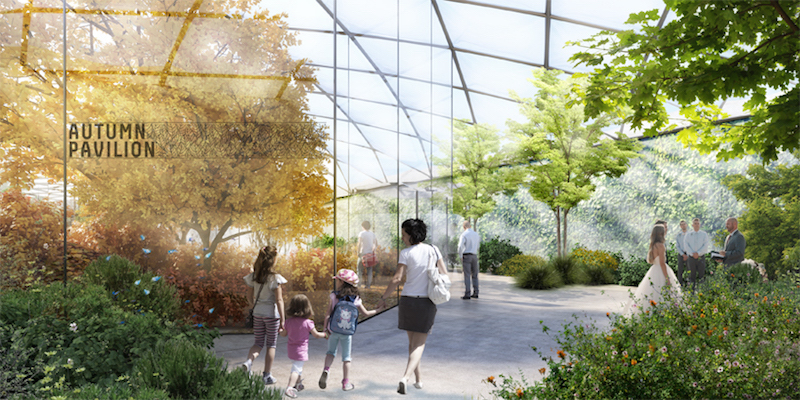Cue the Vivaldi; Carlo Ratti Associati has wild plans for its recently unveiled Garden of the Four Seasons design that will allow visitors to experience all four seasons at once at any point throughout the year.
Commissioned by Citylife, a new neighborhood under development in northwest Milan based on a master plan by Zaha Hadid, Daniel Liebeskind, and Arata Isozaki, Garden of the Four Seasons aims to reclaim a closer relationship between urban dwellers and nature’s cycles, according to Carlo Ratti Associati.
The project is based on a concept by Dr. Barbara Römer, founder of the creative consultancy Studio Römer, and makes use of a new system for high-precision climate control. Incoming solar energy is partially collected through photovoltaics and partially distributed among the different seasonal pavilions (each season will be housed in its own pavilion within the overall garden). All of this is accomplished with net-zero energy consumption.
 Rendering courtesy Carlo Ratti Associati.
Rendering courtesy Carlo Ratti Associati.
A transparent, responsive EFTE membrane is covered with photovoltaic cells to produce clean energy year-round. A heat exchanger takes the captured solar energy and can heat the summer space or cool the winter area. Heat transfer between the pavilions is also possible and allows each one to achieve the desired intermediate environmental conditions.
The EFTE membrane will house hundreds of vegetable species within the garden. Built-in sensors will open and close the membrane for precise regulation of the enclosed environment. Lighting levels and heat, the two main components of plant growth, are closely monitored and regulated, which will allow the plants’ metamorphosis to follow the different seasonal cycles. Additional sensors will measure the quantity of water, temperature, humidity, and nutrients needed by each vegetable species and relay the information as a series of real-time “tweets” coming from the plants about their status.
 Rendering courtesy Carlo Ratti Associati.
Rendering courtesy Carlo Ratti Associati.
Visitors can enter the garden in spring and walk through to winter, observing nature’s transformation along the way. People can dine al fresco during the cold winter months or hold a wedding in the Eternal Spring area.
 Rendering courtesy Carlo Ratti Associati.
Rendering courtesy Carlo Ratti Associati.
The Garden of the Four Seasons will cover over 2500 sm.
Related Stories
| Feb 4, 2011
U.S. Green Building Council applauds President Obama’s Green Building Initiative
The U.S. Green Building Council applauded a key element of President Obama’s plan to “win the future” by making America’s commercial buildings more energy- and resource-efficient over the next decade. The President’s plan, entitled Better Buildings Initiative, catalyzes private-sector investment through a series of incentives to upgrade offices, stores, schools and universities, hospitals and other commercial and municipal buildings.
| Feb 4, 2011
President Obama: 20% improvement in energy efficiency will save $40 billion
President Obama’s Better Buildings Initiative, announced February 3, 2011, aims to achieve a 20% improvement in energy efficiency in commercial buildings by 2020, improvements that will save American businesses $40 billion a year.
| Jan 19, 2011
U.S. Green Building Council Welcomes New Board Directors
The U.S. Green Building Council (USGBC) has announced newly elected officers and new directors to its 2011 Board of Directors, including Elizabeth J. Heider from Skanska; Kirsten Ritchi from Gensler; and Dennis Maloskey, from the Pennsylvania Governor's Green Government Council.
| Jan 7, 2011
Mixed-Use on Steroids
Mixed-use development has been one of the few bright spots in real estate in the last few years. Successful mixed-use projects are almost always located in dense urban or suburban areas, usually close to public transportation. It’s a sign of the times that the residential component tends to be rental rather than for-sale.
| Dec 7, 2010
Blue is the future of green design
Blue design creates places that are not just neutral, but actually add back to the world and is the future of sustainable design and architecture, according to an interview with Paul Eagle, managing director of Perkins+Will, New York; and Janice Barnes, principal at the firm and global discipline leader for planning and strategies.
| Nov 29, 2010
Renovating for Sustainability
Motivated by the prospect of increased property values, reduced utility bills, and an interest in jumping on the sustainability bandwagon, a noted upturn in green building upgrades is helping designers and real estate developers stay busy while waiting for the economy to recover. In fact, many of the larger property management outfits have set up teams to undertake projects seeking LEED for Existing Buildings: Operations & Maintenance (LEED-EBOM, also referred to as LEED-EB), a certification by the U.S. Green Building Council.
| Nov 16, 2010
Brazil Olympics spurring green construction
Brazil's green building industry will expand in the coming years, spurred by construction of low-impact venues being built for the 2016 Olympics. The International Olympic Committee requires arenas built for the 2016 games in Rio de Janeiro meet international standards for low-carbon emissions and energy efficiency. This has boosted local interest in developing real estate with lower environmental impact than existing buildings. The timing couldn’t be better: the Brazilian government is just beginning its long-term infrastructure expansion program.
| Nov 16, 2010
Green building market grows 50% in two years; Green Outlook 2011 report
The U.S. green building market is up 50% from 2008 to 2010—from $42 billion to $55 billion-$71 billion, according to McGraw-Hill Construction's Green Outlook 2011: Green Trends Driving Growth report. Today, a third of all new nonresidential construction is green; in five years, nonresidential green building activity is expected to triple, representing $120 billion to $145 billion in new construction.
| Nov 11, 2010
USGBC certifies more than 1 billion square feet of commercial space
This month, the total footprint of commercial projects certified under the U.S. Green Building Council’s LEED Green Building Rating System surpassed one billion square feet. Another six billion square feet of projects are registered and currently working toward LEED certification around the world. Since 2000, more than 36,000 commercial projects and 38,000 single-family homes have participated in LEED.










